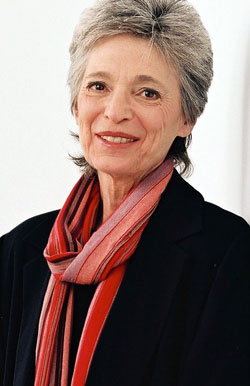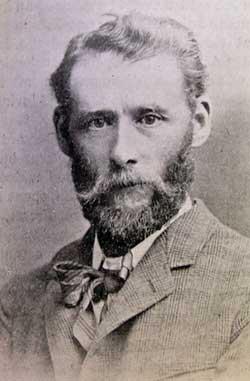Gallery
- Ottawa, Canada 1876
- Dallas, Texas 1872
- Victoria, Texas 1873
- Belleville, Ontario, Canada 1874
- Jefferson, Texas 1872
Herman Brosius | |
|---|---|
| Born | 1851 Milwaukee, Wisconsin, U.S. |
| Died | 1917 (aged 65–66) |
| Nationality | American |
| Occupation | Cartography |
Herman Brosius (1851 - 1917) was an American cartographer who made panoramic maps that were printed at his twin brother Frederick Brosius' firm in Milwaukee, Wisconsin. His work is held in the collection of the Library and Archives Canada, Brock University, [1] and the Museum of Wisconsin Art.
Brosius was born in Milwaukee, Wisconsin. [2] His twin brother Frederick owned the Milwaukee Lithograph and Engraving Company and the brothers collaborated to produce dozens of panoramic maps. [2] Brosius produced several views of Texas municipalities beginning with Jefferson, Texas in 1872 [3]
His earliest map was of Darlington, Wisconsin. During his career, he also produced views of Canadian cities including Ontario [4] and Ottawa.
Brosius died in Milwaulkee. [2]

Cornelius David Krieghoff was a Dutch-born Canadian-American painter of the 19th century. He is best known for his paintings of Canadian genre scenes involving landscapes and outdoor life, which were as sought after in his own time as they are today. He painted many winter scenes, some in several variants.
Port Arthur was a city in Northern Ontario, Canada, located on Lake Superior. In January 1970, it amalgamated with Fort William and the townships of Neebing and McIntyre to form the city of Thunder Bay.

The Milwaukee Art Museum (MAM) is an art museum in Milwaukee, Wisconsin. Its collection contains nearly 25,000 works of art.
The North American Cartographic Information Society (NACIS) is a US-based cartographic society founded in 1980. It was founded by specialists in cartography, which included government mapmakers, map librarians, cartography professors and cartography lab directors. It now represents a broad mixture of academic, government and commercial interests, with a sizeable proportion of working cartographers. Many NACIS members come from related vocations NACIS offers both volunteer opportunities and travel grants for students and members of the community.

The Milwaukee metropolitan area is a major metropolitan area located in Southeastern Wisconsin, consisting of the city of Milwaukee and some of the surrounding area. There are several definitions of the area, including the Milwaukee–Waukesha–West Allis metropolitan area and the Milwaukee–Racine–Waukesha combined statistical area. It is the largest metropolitan area in Wisconsin, and the 39th largest metropolitan area in the United States.

The Toronto Normal School was a teachers college in Toronto, Ontario, Canada. Opened in 1847, the Normal School was located at Church and Gould streets in central Toronto, and was a predecessor to the current Ontario Institute for Studies in Education. The Royal Ontario Museum, the Ontario College of Art & Design and the Ontario Agricultural College all originated at the Normal School's campus and the provincial Department of Education was also located there. Officially named St. James Square, the school became known as "the cradle of Ontario's education system". The school's landmark Gothic-Romanesque building was designed by architects Thomas Ridout and Frederick William Cumberland in 1852. The landmark building was demolished in 1963, but architectural elements of the structure remain on the campus of Toronto Metropolitan University.

Frederick Arthur Verner was a Canadian painter, well-known for his paintings of the First Nations in the Canadian west and for his paintings of buffalo. His pictures of the buffalo were thought to be “a class of subject where he stands almost alone and unrivalled,” said Toronto`s The Globe in 1906. Verner set a standard in this department of art, it added in 1908.

James Frederick Unger was a British-born Canadian cartoonist, best known for his syndicated comic strip Herman which ran for 18 years in 600 newspapers in 25 countries.

Lynne Cohen was an American-Canadian photographer.

Pictorial maps depict a given territory with a more artistic rather than technical style. It is a type of map in contrast to road map, atlas, or topographic map. The cartography can be a sophisticated 3-D perspective landscape or a simple map graphic enlivened with illustrations of buildings, people and animals. They can feature all sorts of varied topics like historical events, legendary figures or local agricultural products and cover anything from an entire continent to a college campus. Drawn by specialized artists and illustrators, pictorial maps are a rich, centuries-old tradition and a diverse art form that ranges from cartoon maps on restaurant placemats to treasured art prints in museums.

Gordon W. Lloyd was an architect of English origin, whose work was primarily in the American Midwest. After being taught by his uncle, Ewan Christian, at the Royal

William Southam was a Canadian newspaper publisher.
Robert Gray Murray is considered by some to be Canada's foremost abstract sculptor. He also has been called the most important sculptor of his generation worldwide. His large outdoor works are said to resemble the abstract stabile style of Alexander Calder, that is, the self-supporting, static, abstract sculptures, dubbed "stabiles" by Jean Arp in 1932 to differentiate them from Calder's mobiles. Murray focused on "trying to get sculpture back to its essential form", he has said. His work is like colour-field abstraction.

The Ideal Scout, also known as The Boy Scout, is the most famous work by Canadian sculptor R. Tait McKenzie (1867–1938). The original statue stood in front of the Cradle of Liberty Council at 22nd and Winter Streets in Philadelphia, Pennsylvania, from 1937 to 2013. Replicas can be found at Boy Scouts of America councils across the United States, as well as at Gilwell Park in London, England, and at Scouts Canada's national office in Ottawa. The Smithsonian American Art Museum's database lists 18 copies.

Hamilton Thomas Carlton Plantagenet MacCarthy was one of the earliest masters of monumental bronze sculpture in Canada. He is known for his historical sculptures, in particular his Pierre Dugua, Sieur de Mons at Annapolis Royal, Nova Scotia (1904) as well as Samuel de Champlain overlooking Parliament Hill on Nepean Point, Ottawa (1915), next to the National Gallery of Canada. His monument to the Ottawa volunteers who died in the South African War (1902) was moved to Confederation Park in 1969 after several moves. Other works include that of Ottawa mayor, Samuel Bingham, in Notre-Dame Cemetery in Vanier.

Jan Serr is an American visual artist who produces a wide range of art including oil paintings, drawings, photographs and prints such as monotypes, lithographs, and etchings.

Frederick Gutekunst was an American photographer from Philadelphia, Pennsylvania. He opened his first photographic portrait studio with his brother in 1854 and successfully ran his business for sixty years. He grew to national prominence during the American Civil War and expanded his business to include two studios and a large phototype printing operation. He is known as the "Dean of American Photographers" due to his high quality portraits of dignitaries and celebrities. He worked as the official photographer of the Pennsylvania Railroad and received national and international recognition for his photographs of the Gettysburg battlefield and an innovative 10-foot long panoramic photograph of the Centennial Exposition.
Clemens Johannes Pauli (1835–1896) was a German-born American photographer and printer who produced panoramic maps with accompanying lists of landmarks at his printing company in Milwaukee, Wisconsin. Several are held at the Library of Congress.
Henry Wellge (1850-1917) was a lithographer in the United States. He produced panoramic maps. He had an office in Milwaukee, Wisconsin.

Camille N. Drie, also known as Camille N. Dry, was a draughtsman active from ca. 1871 to 1904 in the United States. Drie created pictorial maps of various cities including a 110-sheet view of St. Louis, Missouri (1875). The Library of Congress has a collection of his work.